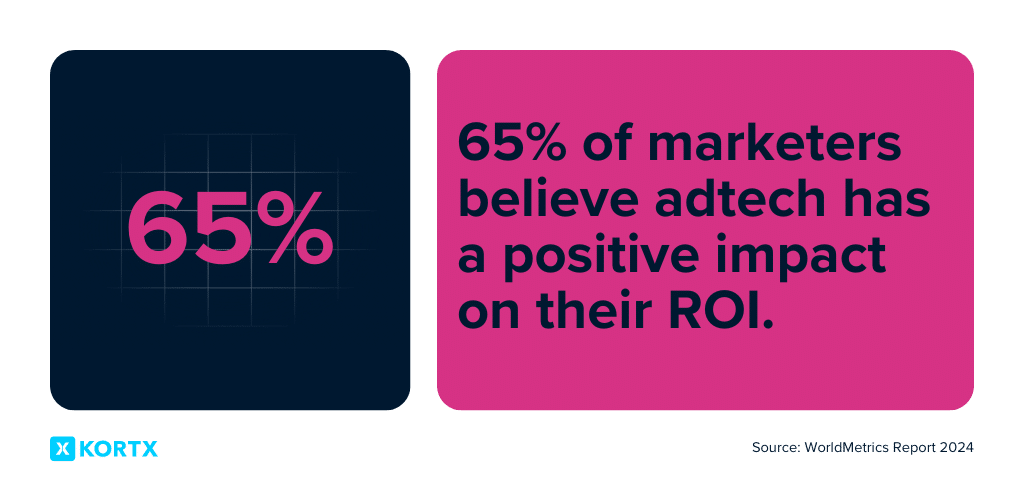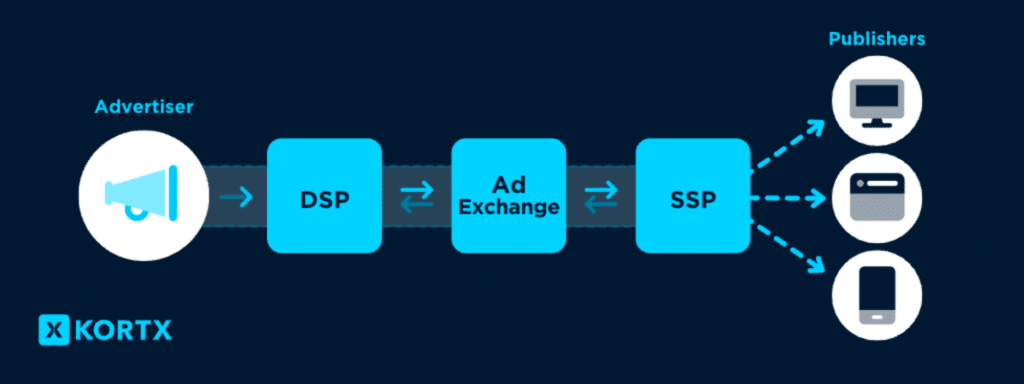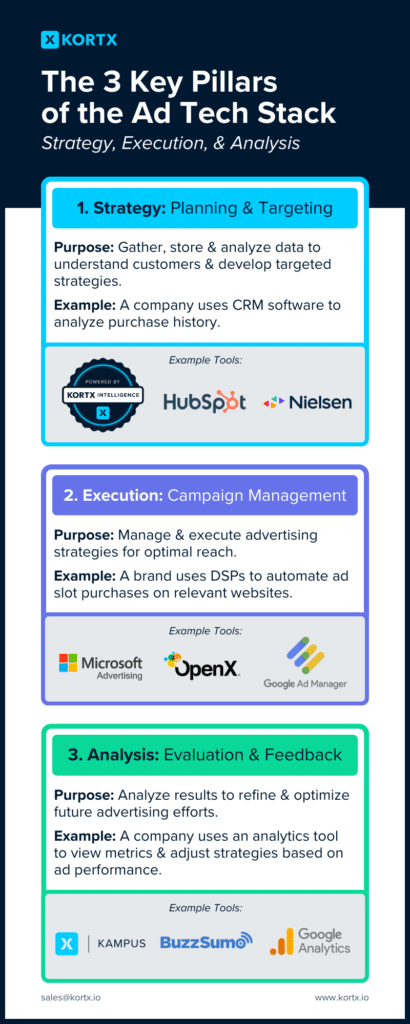Experiences refined for people
Experiences refined for people
44% of marketers have five to ten tools in their tech stack.
Adtech (advertising technology) stacks combine technologies to manage and enhance online advertising campaigns.
They manage tasks from targeting and displaying ads to evaluating campaign success, offering advertisers tools to engage their target audiences.
Explore the common tools and platforms of an adtech stack, how they interact to optimize ROI for both publishers and advertisers, affecting your business strategy.
Adtech (or “ad tech”) refers to the software, systems, platforms, and tools publishers, advertisers, and other parties use to buy, sell, and manage digital advertising.
An adtech stack is a collection of technologies and tools for managing, delivering, and optimizing advertising. Adtech stacks cover targeting, data management, media buying, and performance analysis.
For publishers, an adtech stack means choosing tools to maximize ad revenue.
For advertisers, this involves finding platforms for cost-effective ad distribution.

AdTech is a subcategory of MarTech, specifically dedicated to advertising that bolsters a business’s overarching marketing strategies.
Both AdTech and MarTech serve distinct purposes with varying tools and approaches.
AdTech (Advertising Technology) refers to paid media, consisting of everything that allows a company or advertiser to create and run an advertising campaign and manage and measure performance.
Examples include Display Ads, Digital Out-of-Home, and Interactive Connected TV
MarTech (Marketing Technology) refers to unpaid media. It consists of software and tools that assist in executing overall marketing strategies across various channels, such as email and social media.
Examples include Organic Search (SEO), Email Marketing, and Social Media Posts (unpaid/organic)
What are the benefits of a developed adtech stack?
“An adtech stack helps make workflows smoother, saves money, and boosts digital ad performance. advertising tools should seamlessly work together. This provides accurate data about how well your campaigns are doing. You should tweak and customize your ad tech stack to fit your needs to invest in what yields the best results. The right adtech stack allows digital marketers to optimize their campaigns across multiple channels, like display ads, video ads, and social media ads, all integrated into an ad tech stack.”
An ad tech stack is a set of software tools that streamline and improve the digital advertising process.
Each part of the ad tech stack has a job: delivering, managing, and/or optimizing digital ads to boost ROI for advertisers and revenue for publishers.
The types of adtech software used in programmatic advertising include:
DSPs allow advertisers to purchase ad inventory in real time across various platforms. They enable the automation of buying display, online video (OLV), mobile, paid search ads, and more.
Examples:
SSPs help publishers manage and optimize ad inventory sales, improving revenue by connecting inventory with multiple ad exchanges, DSPs, and ad networks in real-time.
Examples:
DMPs collect and manage data from outside sources, offering insights to advertisers and publishers for more effective ad targeting. They facilitate the creation of audience segments based on detailed attributes like behavior, demographics, and interests.
Examples:
Ad exchanges are digital marketplaces that facilitate the buying and selling of media ad space by connecting advertisers with publishers. They’re critical for programmatic advertising, enabling real-time bidding (RTB).
Examples:

How the RTB (Real-Time Bidding) process works.
Ad servers store, manage, and deliver ads for websites, determining which to display based on factors like the viewer’s location, browsing history, and device.
Examples:
Analytics and attribution tools gauge ad campaign performance, offering data on metrics such as impressions, clicks, conversions, and ROI. They help assess ad effectiveness and refine strategies.
Examples:
CMPs simplify the management of user consent for data processing across digital platforms. They collect, organize, and help respect user preferences on data usage and privacy. CMPs ensure compliance with regulations like GDPR (General Data Protection Regulation) and CCPA (California Consumer Privacy Act), fostering audience trust and transparency.
Examples:
How do CMPs work, and do businesses need them?
“CMPs are the little banners that ask you to accept or reject cookies when you visit a website. If you’re using cookies on your site and your users are in a geographic location with internet privacy laws (which is in most places nowadays), you probably need a CMP to avoid legal trouble. You can either build your own CMP, buy a Third-Party one, or work with a revenue partner who handles consent and tracking for you. Building your own CMP is best for large publishers with specific needs, while buying a Third-Party one is simpler but can be pricey and uncertain in terms of compliance.”
The ad tech stack revolves around three main pillars: Strategy, Analysis, and Execution. These pillars are vital for smooth marketing operations. Each tool listed above fits into different parts of the ad tech stack.
Effective adtech starts with a strong targeting and data management strategy.
These tools gather, store, and analyze data to form a deep understanding of customers, laying the groundwork for targeted advertising strategies.
First-Party data is especially valuable because it is collected directly from your audience through interactions with your brand, such as website visits, purchases, and customer feedback. 1P helps build detailed customer profiles and predict future behaviors with greater accuracy.
Planning & Targeting tools include:
Example: Using CRM software, a company identifies customers interested in similar products by analyzing their purchase history and engagement. A DMP then refines these segments by integrating behavioral data. With these tools, advertisers can target ad campaigns that resonate with specific consumer preferences.
Campaign management involves coordinating, executing, and optimizing advertising strategies for maximum reach and engagement.
Execution includes using platforms to manage and execute advertising strategies, such as automated ad space buying and dynamic ad placement for optimal reach and engagement.
Campaign management tools include:
Example: An e-commerce brand uses DSPs to automate the purchase of ad slots on relevant websites, targeting users who have recently searched for similar products.
After campaign execution, this pillar analyzes results to refine and optimize future advertising efforts based on data-driven insights.
Evaluation and feedback tools include:
Example: A company running a digital advertising campaign could use an advanced marketing platform, like Kampus, to view critical metrics and adjust its strategy based on the ad’s current performance.

For businesses leveraging digital advertising, here’s a streamlined approach to identify gaps and opportunities within your current adtech ecosystem:
Begin by thoroughly identifying and understanding the components of your current stack. This involves scrutinizing each area of your digital advertising operations across the three key pillars: Strategy, Execution, and Analysis.
By identifying your current stack, you can map out your current AdTech stack, uncover areas that require enhancement or further investment, and remove tools you’re no longer using.
Understanding where and how revenue is generated is crucial. It’s important to analyze which marketing activities or campaigns contribute most significantly to your revenue and assess whether your current adtech solutions adequately support these strategies.
This step involves:
Review your digital marketing’s financial performance to pinpoint which products, services, or marketing channels generate the most revenue. This might involve breaking down revenue through digital advertising channels like social media, search engines, or Connected TV (CTV).
Determine if your current adtech tools successfully support revenue-generating activities.
Example: Does your DSP effectively deliver CTV ads with precise targeting, optimal placements, and budget efficiency that meet marketing goals and boost ad revenue?
If the data shows a high viewership but a low engagement rate, consider adjusting your targeting criteria or ad creative to better align with audience preferences and increase ad revenue. You may also want to examine whether or not your DSP has the right inventory for your target audience.
Analyze the cost of your adtech investments against the revenue generated. For instance, if the DSP is a major part of your ad delivery for CTV, evaluate if the ad performance and the sales outcomes justify the expenses.
Consider variables like ad reach, engagement rates, conversion rates, and overall sales growth from CTV campaigns compared to service prices, time spent, and efficiency.
Based on the analysis, decide whether to enhance, replace, or maintain current adtech tools. For instance, if analysis shows the current DSP lacks features to boost CTV ad revenue, consider upgrading or supplementing it with an additional analytics platform.
How can teams assess their current adtech stack?
“Take stock of the skills available within your team and the capabilities of your existing adtech tools. Are there areas where your team lacks expertise or tools that are underperforming? Recognizing these weaknesses is essential for determining whether to invest in training, new hires, or upgrading your technology.”
Look for any tools or data that are being underutilized. Sometimes, the gap isn’t in the tools you lack but in not fully implementing the tools you already have. This could mean you’re missing out on valuable insights or efficiencies because features are not being used to their full potential.
We designed Kampus, an ad campaign management platform, to improve efficiency, accuracy, and strategic decision-making, leading to superior marketing results.
If gaps in your capabilities cannot be easily filled internally, consider outsourcing those tasks. This could involve using external agencies to manage certain aspects of your campaigns or adopting new technologies that offer more comprehensive solutions than those currently in use.
Make this assessment an ongoing process rather than a one-time review. Regular reviews, at least once a year, keep your adtech stack aligned with your business goals and the latest market opportunities.
For publishers, an adtech stack is about choosing tools that maximize ad revenue, while for advertisers, it’s about finding platforms that facilitate cost-effective ad distribution. Whether DSPs for purchasing advertising inventory, SSPs for managing ad sales, or analytics tools for performance measurement, each component plays an important role.
By continuously evaluating and refining your adtech stack, businesses can stay ahead of market trends, adapt to new challenges, and achieve sustained success in their digital advertising efforts.
We have 10+ years of experience driving growth for our brands and clients.
Brandon Pollard is the Director of Ad Operations at KORTX. He enjoys cloud rap, soccer, and traveling.
From us to your inbox weekly.